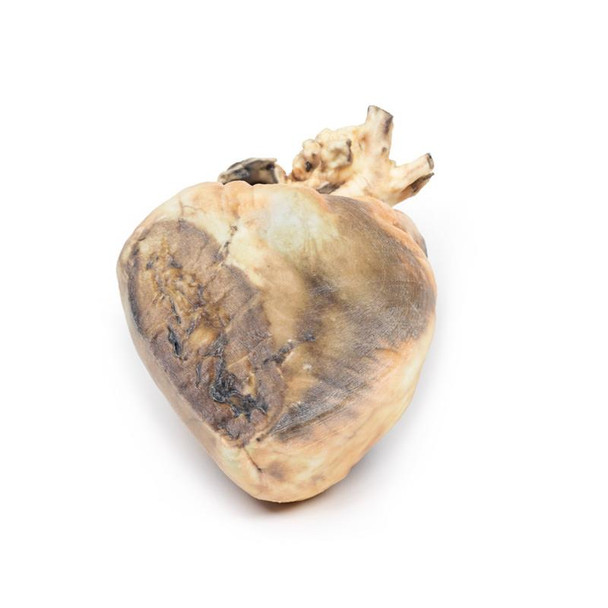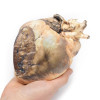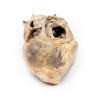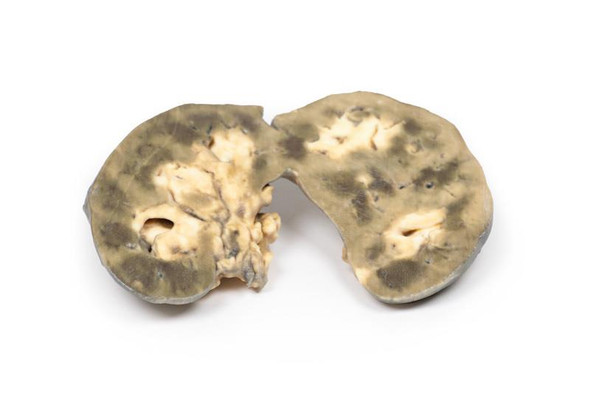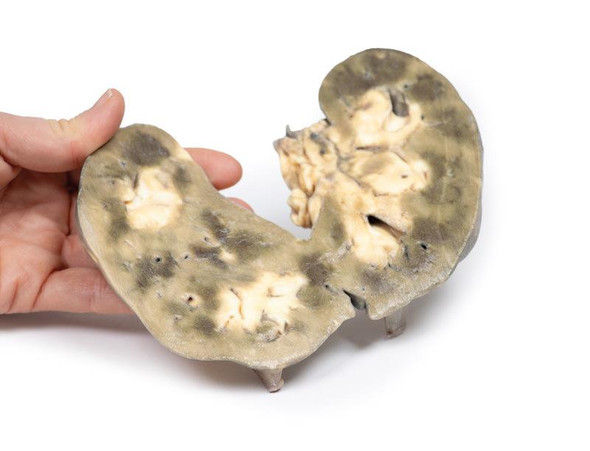Description
Clinical History
A 10-year-old girl with a known congenital heart was admitted for surgical repair because of the recent onset of cyanosis and cardiac failure. On examination, she was breathless with a blood pressure of 105/60mm/Hg and a pulse rate of 140/min. There was a loud heart murmur in the fourth left intercostal space adjacent to the sternum. The jugular venous pressure was elevated, and there were bilateral pulmonary basal crepitations but no peripheral oedema. At operation, the defect was repaired; however, death followed a sudden post-operative deterioration of unknown cause.
Pathology
The heart is viewed from the left side. The left atrium has been opened to display a large ovoid defect 3.5 cm in greatest diameter in the inter-atrial septum. Only a small posteroinferior crescentic rim of septum remains. The left ventricle is small, and the right ventricle is hypertrophied (see posterior aspect of specimen where part of the right posterolateral wall of the right ventricle has been cut away to demonstrate the thickened wall). The pulmonary artery, seen to the left of the atrial cavities, is greatly enlarged. The smaller vessel seen lying above the cut end of the pulmonary artery is the aortic arch. The cut edge of a lumen 8 mm in diameter immediately below the cut end of the pulmonary artery is the left auricular appendage.
Further Information
Atrial septal defect is usually asymptomatic early in life, even when large. Symptoms may not develop until adult life. The onset of symptoms is due to reversal of the initial left-to-right shunt as a result of increasing right ventricular hypertrophy and pulmonary hypertension. The ensuing right-to-left shunt is associated with cyanosis and dyspnoea, and ultimately leads to congestive cardiac failure.
There are several types of atrial septal defects, including:
Secundum - This is the most common type of ASD and occurs in the middle of the wall between the atria (atrial septum). Primum - This defect occurs in the lower part of the atrial septum and might occur with other congenital heart problems.
Sinus venosus - This rare defect usually occurs in the upper part of the atrial septum and is often associated with other congenital heart problems.
Coronary sinus - In this rare defect, part of the wall between the coronary sinus which is part of the vein system of the heart and the left atrium is missing.
It is not known why all atrial septal defects occur, but some congenital heart defects appear to be familial and sometimes occur with other genetic problems, such as Trisomy 21 (Down's syndrome). Some conditions during pregnancy can increase the risk of having a baby with a heart defect, including acute infections such as Rubella infection; drug, tobacco or alcohol use, or exposure to certain substances (such as cocaine) during the first trimester of pregnancy; and underlying systemic conditions, such as diabetes or systemic lupus erythematosus.
Advantages
- Anatomically accurate and identical to real specimen
- No ethical issues - not real human body parts
- Reasonably priced
- Available within a short lead time
- Reproducible, several identical prints can be used as a classroom set
- Can be produced in different sizes to cater for the needs of the teacher
Human Cadavers
- Access to cadavers can be problematic. Many countries cannot access cadavers for cultural and religious reasons
- Cadavers cost a lot money
- High cost for establishing your own plastination suite
- Wet specimens cannot be used in uncertified labs
- Dissection of cadavers is a lot of staff time and that is a cost
- Storage of cadaver material needs special refrigeration etc. which has coast
- If you want another specimen you have to start all over again
Plastinates
- Costs
- Ethical issues
- Timeframe for plastination process
- Many countries do not allow their importation
- One of a kind
Superior 3D print results compared with conventional methods
- Vibrant color offering with 10 million colors
- UV-curable inkjet printing
- High quality 3D printing that can create products that are delicate, extremely precise and incredibly realistic
Clear Support Material
- To avoid breakage of fragile, thin, and delicate arteries, veins or vessels, a clear support material is printed on such spots. This makes the models robust and can be handled by students easily.
